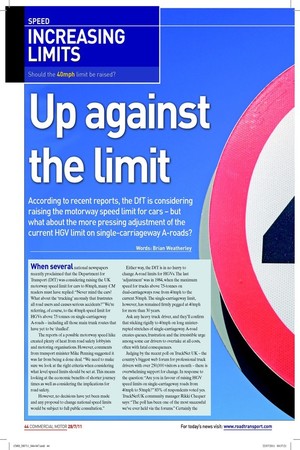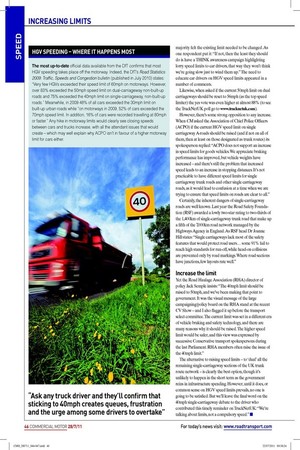Up against the limit
Page 36

Page 38

If you've noticed an error in this article please click here to report it so we can fix it.
According to recent reports, the DfT is considering raising the motorway speed limit for cars – but what about the more pressing adjustment of the current HGV limit on single-carriageway A-roads?
Words: Brian Weatherley
When several national newspapers recently proclaimed that the Department for Transport (DfT) was considering raising the UK motorway speed limit for cars to 80mph, many CM readers must have replied: “Never mind the cars! What about the ‘trucking’ anomaly that frustrates all road users and causes serious accidents?” We’re referring, of course, to the 40mph speed limit for HGVs above 7.5 tonnes on single-carriageway A-roads – including all those main trunk routes that have yet to be ‘dualled’ .
The reports of a possible motorway speed hike created plenty of heat from road safety lobbyists and motoring organisations. However, comments from transport minister Mike Penning suggested it was far from being a done deal. “We need to make sure we look at the right criteria when considering what level speed limits should be set at. This means looking at the economic beneits of shorter journey times as well as considering the implications for road safety.
However, no decisions have yet been made and any proposal to change national speed limits would be subject to full public consultation.” Either way, the DfT is in no hurry to change A-road limits for HGVs. The last ‘adjustment’ was in 1984, when the maximum speed for trucks above 7.5-tonnes on dual-carriageways rose from 40mph to the current 50mph. The single-carriageway limit, however, has remained irmly pegged at 40mph for more than 30 years.
Ask any heavy truck driver, and they’ll conirm that sticking rigidly to 40mph on long uninterrupted stretches of single-carriageway A-road creates queues, frustration and the irresistible urge among some car drivers to overtake at all costs, often with fatal consequences.
Judging by the recent poll on TruckNet UK – the country’s biggest web forum for professional truck drivers with over 250,000 visitors a month – there is overwhelming support for change. In response to the question: “Are you in favour of raising HGV speed limits on single-carriageway roads from 40mph to 50mph?” 83% of respondents voted yes. TruckNetUK community manager Rikki Chequer says: “The poll has been one of the most successful we’ve ever held via the forums.” Certainly the majority felt the existing limit needed to be changed. As one respondent put it: “If not, then the least they should do is have a THINK awareness campaign highlighting lorry speed limits to car drivers, that way they won’t think we’re going slow just to wind them up.” The need to educate car drivers on HGV speed limits appeared in a number of comments.
Likewise, when asked if the current 50mph limit on dual carriageways should be reset to 56mph (as the top speed limiter) the yes vote was even higher at almost 88% (to see the TruckNetUK poll go to www.trucknetuk.com).
However, there’s some strong opposition to any increase. When CM asked the Association of Chief Police Oficers (ACPO) if the current HGV speed limit on single carriageway A-roads should be raised (and if not on all of them, then at least on those designated as trunk routes) its spokesperson replied: “ACPO does not support an increase in speed limits for goods vehicles. We appreciate braking performance has improved, but vehicle weights have increased – and there’s still the problem that increased speed leads to an increase in stopping distances. It’s not practicable to have different speed limits for single carriageway trunk roads and other single carriageway roads, as it would lead to confusion at a time when we are trying to ensure that speed limits on roads are clear to all.” Certainly, the inherent dangers of single-carriageway roads are well known. Last year the Road Safety Foundation (RSF) awarded a lowly two-star rating to two-thirds of the 1,400km of single-carriageway trunk road that make up a ifth of the 7,000km road network managed by the Highways Agency in England. As RSF head Dr Joanne Hill states: “Single carriageways lack most of the safety features that would protect road users... some 91% fail to reach high standards for run-off, while head-on collisions are prevented only by road markings. Where road sections have junctions, few layouts rate well.”
Increase the limit
Yet the Road Haulage Association (RHA) director of policy Jack Semple insists: “The 40mph limit should be raised to 50mph, and we’ve been making that point to government. It was the visual message of the large campaigning/policy board on the RHA stand at the recent CV Show – and I also lagged it up before the transport select committee. The current limit was set in a different era of vehicle braking and safety technology, and there are many reasons why it should be raised. The higher speed limit would be safer, and this view was expressed by successive Conservative transport spokespersons during the last Parliament. RHA members often raise the issue of the 40mph limit.”
The alternative to raising speed limits – to ‘dual’ all the remaining single-carriageway sections of the UK trunk route network – is clearly the best option, though it’s unlikely to happen in the short term as the government reins in infrastructure spending. However, until it does, or common sense on HGV speed limits prevails, no one is going to be satisied. But we’ll leave the inal word on the 40mph single-carriageway debate to the driver who contributed this timely reminder on TruckNetUK: “We’re talking about limits, not a compulsory speed.” ■











































